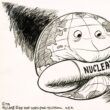Just say no
By Mark Gubrud, June 24, 2015
Hypersonic flight may sound like screaming good fun—but it’s not meant for you. It’s meant for weapons that would probably be used only in the opening salvos of a nuclear war.
No nation has yet succeeded in developing non-ballistic missiles that fly long distances at or above Mach 5 (five times the speed of sound), but the United States and China are conducting tests. Russia and India say they are jointly developing a hypersonic missile. Pakistan, of course, must do whatever India does. France will find that it cannot be France without hypersonic missiles, while Britain must never falter… and on and on it will go, in a new round of an old arms race that still leads only to stalemate or oblivion. Fortunately, there is a simple, risk-free, and highly verifiable way to avoid this dismal prospect: ban tests of hypersonic missiles.
Why does anyone want hypersonic missiles anyway? For more than half a century, ballistic missiles have provided the capability to hurl warheads above the atmosphere and hit any spot on the globe within minutes. The concept of hypersonic missiles, which would plow through the atmosphere at a fraction of the speed, has been around almost as long—but the extreme stresses, high temperatures, and corrosive effects of hypersonic flight have frustrated efforts to develop practical weapons. Ballistic missiles are simpler, cheaper, faster, and can reliably defeat missile defenses with lightweight decoys and other simple countermeasures.
With their high costs and small payloads, hypersonic missiles would be ill-suited to a sustained military campaign, but could be useful as tip-of-the-spear weapons. Armed with conventional warheads and their own kinetic energy, they could attack ships, radar and communications antennas, command and weapons bunkers, airfields, missile launchers, and other strategic assets. They could also carry nuclear warheads, and could fly in under the radars that watch for ballistic missiles. US strategists propose that hypersonic weapons could be used for “conventional prompt global strike” without the risk of being mistaken for a nuclear attack—yet Washington alleges that China intends its hypersonics for nuclear delivery.
Testing so far. Hypersonic missiles come in two main flavors: boost-glide vehicles and powered-flight cruise missiles.
For boost-glide vehicles, a rocket is used to launch a glider on a high trajectory into space. When it re-enters the atmosphere, the glider pulls up to fly horizontally, unpowered, for up to thousands of miles at initial speeds in the high hypersonic range, Mach 10 to 20 (about 7,000 to 14,000 miles per hour).
The United States tested a boost glide vehicle at the high end of this speed range in 2010 and 2011, but the tests ended in failure. Another program, the Advanced Hypersonic Weapon, aimed at lower speeds (around Mach 12) and reportedly experienced success in November 2011. But in a second test in August 2014, the same weapon blew up over the launch pad. China, meanwhile, conducted three tests of its own hypersonic glide vehicle, known as the WU-14, in 2014. China’s second test, in August, was a spectacular failure; the January and December tests are widely assumed to have been at least partial successes. A fourth test, also apparently successful, was reported just weeks ago.
Hypersonic cruise missiles, on the other hand, would be boosted initially by a small rocket and then powered by a supersonic combustion ramjet (or scramjet) for flight in the low hypersonic range—Mach 5 to 10, or around 3,000 to 7,000 miles per hour. They would cover distances up to about 600 miles. Such weapons would be ideally suited for naval strikes, land strikes from air or naval platforms, or cross-border surprise attacks between neighboring countries.
In May 2013, the United States became the only nation known to have successfully tested such a missile, the X-51A, a prototype for the planned High Speed Strike Weapon, which would cruise at about Mach 5. But China is reportedly working on similar technology and studying concepts for its use. Russia and India, meanwhile, jointly market a ramjet-powered supersonic cruise missile known as BrahMos, based on a Soviet-era design. They have announced a project to produce a hypersonic follow-on, the BrahMos 2, which they say will fly at Mach 7.
Testing no more. In the tests conducted so far, successes have demonstrated that it's possible to build functional hypersonic weapons—indeed, if work continues, hypersonics are likely to become reality over the next decade. Failures, meanwhile, show that developing reliable and militarily useful hypersonic weapons is impossible without testing.
A hypersonic test ban would be strong arms control. No nation would base preemptive strategic attack plans on weapons that have not been thoroughly tested, debugged, and proven reliable.
A ban would also be verifiable. While development of hypersonic missiles can be conducted in laboratories and wind tunnels to some extent, the kind of full-up tests needed to confirm performance and debug problems can only be carried out in the open air—in full view of sensors based in space, at sea, on land, and even in the hands of ordinary people.
It could begin with an informal moratorium. The United States, China, Russia, or India could initiate a moratorium by announcing that it was putting on hold plans for future hypersonic testing—while inviting other nations to postpone their own tests and to seek a permanent ban. In time, a convention could be organized where the precise parameters of a global ban could be negotiated and a formal treaty could be drafted.
Initiating or joining a test moratorium and adhering to a ban would involve little risk. Hypersonic missiles represent an escalation of strategic threat but are hardly sufficient to ensure a successful disarming first strike. And no nation would be able to secretly perfect and then mass-produce the weapons so quickly that rivals would have no chance to catch on and catch up.
Babies and bathwater. Some will argue that banning hypersonic missiles would prevent the development of hypersonic “space planes” that could cross oceans in an hour, or fly to orbit. In reality, the economics of such concepts are highly dubious. But a hypersonic missile test ban need not stand in their way. Missiles are easy to distinguish from the much larger vehicles that might make sense as space planes. A treaty could specify the technical criteria needed to make that distinction, as well as express the intent not to block peaceful activities.
Hypersonic missiles are just one aspect of a renewed strategic arms race among the world’s major nuclear-armed powers. Sources of this resurgent danger include smoldering geopolitical rivalries, shifts in economic power, and new weapons made possible by emerging technology. The world has failed so far to put the nuclear genie back in the bottle, and new genies are now getting loose: space weapons, cyber warfare, drones, and autonomous weapons. Weapons based on synthetic biology and nanotechnology loom on the horizon.
Seen in this context, a test ban for hypersonic weapons stands out as an easy and highly significant opportunity to resist an onslaught of destabilizing weapons technology. Let's just say no to hypersonic weapons.
Topics: Nuclear Weapons, Technology and Security
Share: [addthis tool="addthis_inline_share_toolbox"]














